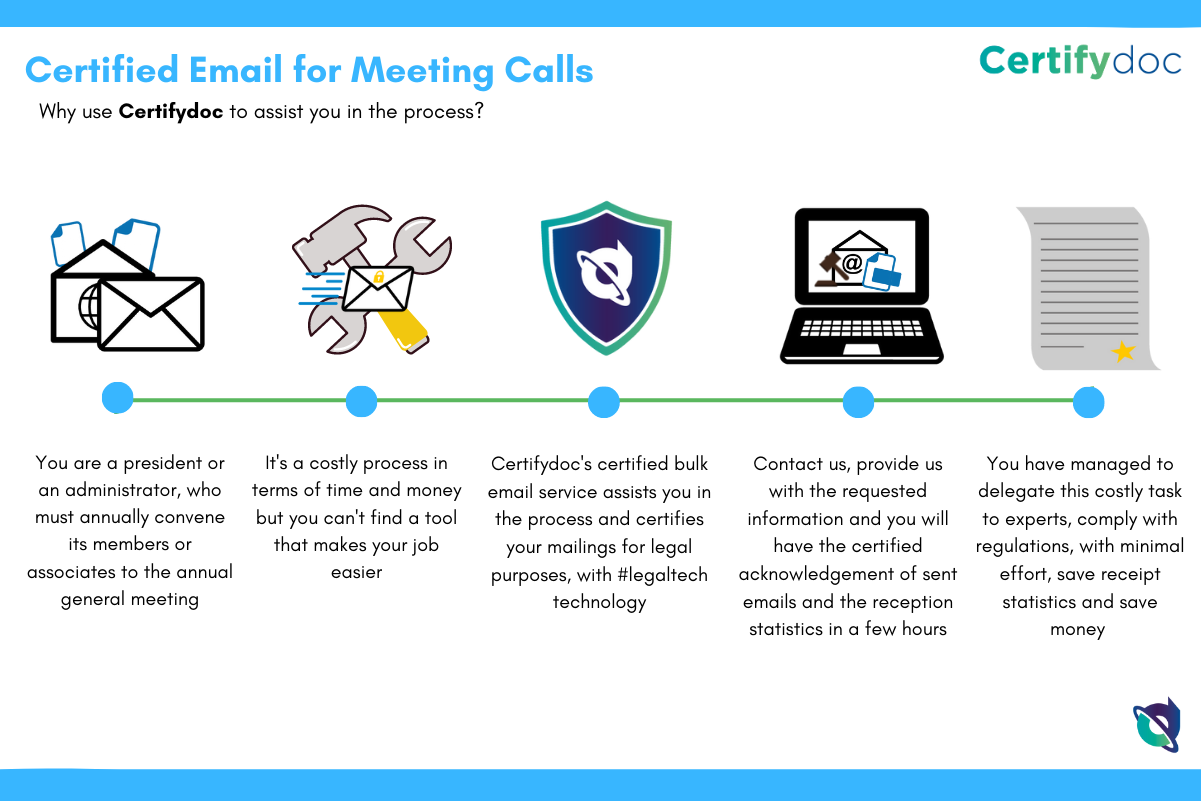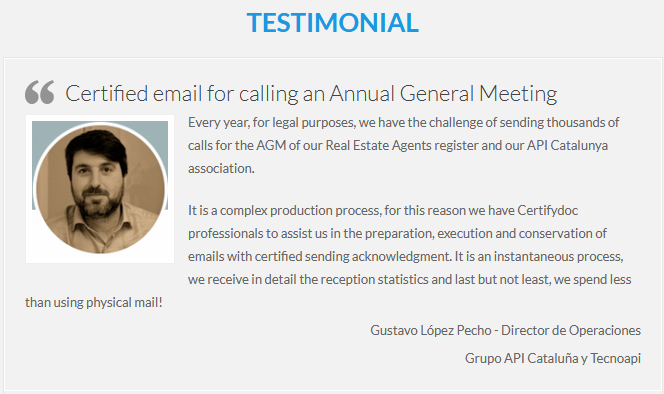Certifydoc Certified Email

Why should you delegate mass certified email to Certifydoc experts?
Save time, money, trust from your partners and associates by complying with regulations and giving reputation and security over the years.
If you have to periodically send notices for ordinary or extraordinary meetings and you need to send a large number of emails, benefit from the assistance of Certifydoc’s professionals and provide for conflicts, exceptions and cancellations, by sending an email with certified mailing acknowledgement.
With this innovative #legaltech solution, administrators, managers and legal advisors can count on an accurate, controlled, high quality and customized submission process, which delegates to experts the management of the technical complexity of privacy and cybersecurity, electronic certifications and digital evidence.
The shipping process is carefully prepared by planning dates and trials. In a few hours, a text with any kind of attachments or excel can be transformed into a mass mailing with high evidentiary efficiency, transparency, traceability and it is designed to be easily archived and used if needed.
It is important to clarify some very ambiguous concepts in the networks.
- Voluntary acknowledgement of receipt:
The recipient cannot be obliged to acknowledge receipt. Therefore, if we do not have the consent of the recipient, a certified delivery can only guarantee that the email has been sent and reached the recipient’s server. You cannot guarantee, for example, that you have opened it, read it or when any of this occurred. From here on, any additional traceability data can only be provided with the recipient’s voluntary consent. This implies that the user’s receipt data cannot be guaranteed, they are optional. - Forcing the recipient to lose privacy:
Likewise, forcing the user to log in or register in order to view the content of the email, and thus be traced, is a practice that could be counterproductive. A user could claim that his or her right to privacy and intimacy has been violated by being forced to trace (give his or her data) to see the content of a communication. - Requirements for automatic acknowledgment of receipt by the member: the voluntariness required to validate the acknowledgment of receipt can be foreseen. This is true for an organization that has simultaneously met these two conditions: Included in its bylaws the correct clauses for notification by email, and that it has voluntarily received from the member an email for notification purposes. Thus understanding that, once the mail is sent voluntarily and in compliance with the provisions of the bylaws, the acknowledgment of receipt would be implicit, as stated in the DGRN Resolution of July 19, 2019, for example.
- Accredited Certifiers:
It is essential to verify that the certification authority is clearly indicated whether it is published in the EU’s list of qualified certifiers and qualified service providers of the state government or are unaccredited certifiers. https://www.certifydoc.eu/es/#certifiedby
- Data preparation:
The client provides (1) the sender’s email and (2) the sender’s receiving email of all certified mailings of the call, (3) the content and attachments of the call in an email (it is recommended not to exceed 1MB but the system supports mailings up to 10MB per email) and (4) another email with the Excel or csv file that includes the email addresses of the recipients of the call. - Test submissions:
The service sends a test email to verify the proper functioning of the process and traceability. - Certified delivery:
Progressively sent to each of the recipients with cc: (2) the sender’s receiving email address, which must be able to receive all certified emails and archive them properly. - Reception statistics:
The service sends to the sender, in a few days, a final excel summary where it collects the aggregated data of the reception statistics for each sending, properly sorted for future reference or to present as evidence; finally it deletes all the sent emails from its systems for privacy reasons.
When is it appropriate to certify the acknowledgement of delivery?
The most common way to comply with sending the call for meetings instead of announcing it on the website is to send the notice by ordinary mail to the address of all the addressees, if the bylaws so provide (Art. 173.2 LSC, in Spain for example). It is important to note that for economic reasons, this method is purely a return receipt process, without certified receipt or bureaufax. The new technologies of qualified electronic signatures and qualified time-stamping, granted by state and EU accredited certification service providers, and the new European legal framework allow to benefit from new solutions such as certified e-mail.
When we talk about certified email, it is essential to know all the details of the type of service, because they make a difference in its usefulness and level of legal relevance.
As expected, with the appropriate knowledge, we can achieve that the email with the mass certified mailing acknowledgement obtains at least the same results as the physical one.
If properly managed, it can even provide most of the characteristics of the bureaufax, adding the advantages of voluntary acknowledgement of receipt by the addressees and all the voluntary and involuntary traceability, with a lower cost, immediately, and savings in administrative management.
Article 1100 Civil Code describes the defaulter as “those obliged to surrender or do anything since the creditor requires them to be legally or extrajudicially required to fulfill their obligation”.
The condition of defaulter in the real estate case is given by the non-payment of the debt by the owner or owners. Article 21 of the Horizontal Property Act is the one that regulates the monitoring process. It is a voluntary process by which the debt claim is notified. The notification of the procedure must be made as established in art. 9.1.h, at the address in Spain for the purpose of notifications and summons indicated by the co-owner, if there is no indication, the apartment or premises of the Community will be considered as the address.
A burofax or certified email can be used for notification. In the event that the apartment or premises belong to several owners, the notification must be made to each and every one of the owners.
- Signing contracts and sending invoices
- Labor issues such as layoffs, serious misdemeanors, etc.
- Couples in separations and child custody
- Administrative issues of inheritance and management of older adults.
- Quantity claims
- Notifications to suppliers, freelancers and professionals
- Domestic violence and bullying
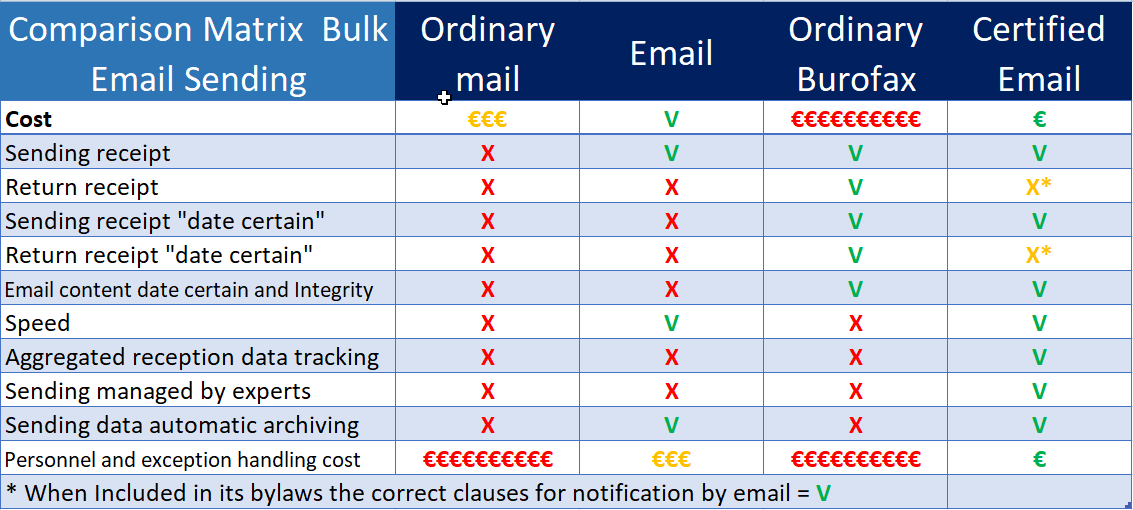

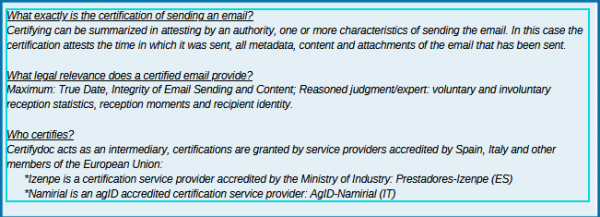
Pricing
- Volume discount 0%
- - Volume example 40
- - Price 80,00 €
- - Price per email 2,00 €
- Volume discount 55,6%
- - Volume example 500
- - Price 378,00 €
- - Price per email 0,76 €
- Volume discount 76,6%
- - Volume example 5.000
- - Price 1.504,00 €
- - Price per email 0,3 €
- Volume discount 81%
- - Volume example 10.000
- - Price 2.674,00 €
- - Price per email 0,27 €
Download the ‘Certified email’ PDF which includes detailed information
Certifydoc Certified Email for Mass Meeting Calls
Discover the advantages of using Certifydoc’s assisted service in a short informative video.
By loading this video, you agree to the privacy policy of Youtube.
Legal
- With Certifydoc you can prove to lawyers and justice, with maximum legal relevance, both the date on which your emails have been sent, and that they have not been manipulated later, and with high legal relevance the statistics of voluntary and involuntary reception.
- Certifydoc acts as an intermediary, certifications are granted by the certification authorities of Spain and other members of the European Union, through qualified time stamping.
In our Blog you can find more information about qualified time stamping, about certification authorities and several final judgments involving certified tests with Certifydoc.
